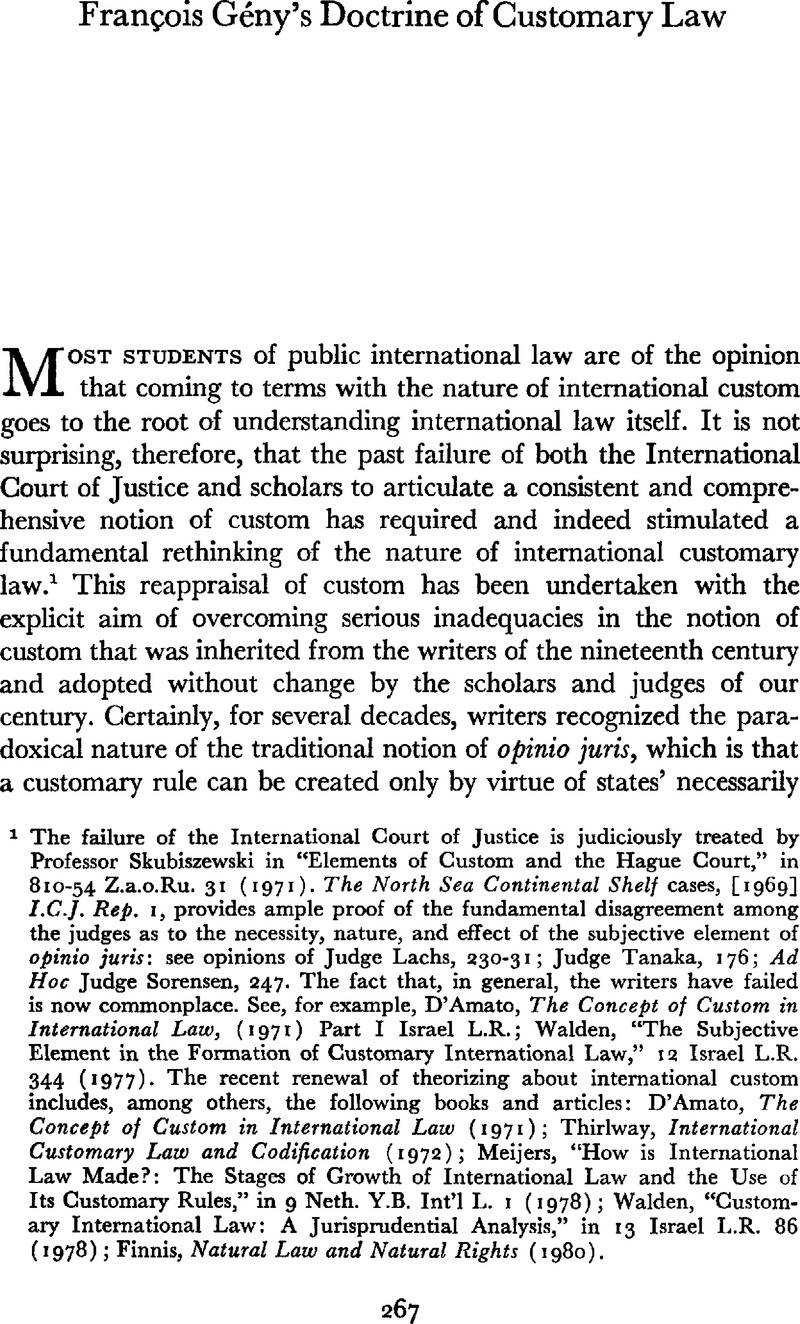Published online by Cambridge University Press: 09 March 2016

1 The failure of the International Court of Justice is judiciously treated by ProfessorSkubiszewski, in “Elements of Custom and the Hague Court,” in 810–54 Z.a.o.Ru. 31 (1971)Google Scholar. The North Sea Continental Shelf cases, [1969] I.C.J. Rep. ι, provides ample proof of the fundamental disagreement among the judges as to the necessity, nature, and effect of the subjective element of opinio juris: see opinions of Judge Lachs, 230-31; Judge Tanaka, 176; Ad Hoc Judge Sorensen, 247. The fact that, in general, the writers have failed is now commonplace. See, for example, D’Amato, , The Concept of Custom in International Law, (1971)Google Scholar Part I Israel L.R.; Walden, , “The Subjective Element in the Formation of Customary International Law,” 13 Israel L.R. 344 (1977)CrossRefGoogle Scholar. The recent renewal of theorizing about international custom includes, among others, the following books and articles: D’Amato, , The Concept of Custom in International Law (1971)Google Scholar; Thirlway, , International Customary Law and Codification (1972)Google Scholar; Meijers, , “How is International Law Made?: The Stages of Growth of International Law and the Use of Its Customary Rules,” in 9 Neth. Y.B. Int’l L. 1 (1978)Google Scholar; Walden, , “Customary International Law: A Jurisprudential Analysis,” in 13 Israel L.R. 86 (1978)Google Scholar; Finnis, , Natural Law and Natural Rights (1980).Google Scholar
2 See, for example, Kunz, Josef, “The Nature of Customary International Law,” in 47 Am. J. Int’l L. 662, at 667.CrossRefGoogle Scholar
3 See, for example, Kelsen, , Principles of International Law 307 (1952).Google Scholar
4 The most systematic and remarkable argument to this effect is found in Finnis’s Natural Law and Natural Rights 230–45.
5 It is interesting to note that Judge Lachs, in the Continental Shelf case, stated that “[states] may also have been convinced that the instrument … was intended to become and would in due course become general law (the teleological element is of no small importance in the formation of law)” in [1969] I.C.J. Rep. at 230–31; quoted in Thirlway, op. cit. supra note 1, at 54•
6 Thirlway, op. cit. supra note 1, at 55.
7 The outstanding feature of Finnis’s account is that it does precisely this.
8 The present renewal of theorizing was preceded by historical as well as critical investigations into the origins of the dominant conception of custom. See, for example, Guggenheim, Paul, “Contribution à l’Histoire des Sources du Droit des Gens,” in 94 Hague Recueil des Cours 5–82 (1958, II)Google Scholar; Walden, “The Subjective Element in the Formation of Customary International Law,” supra note 1.
9 Guggenheim, supra 52–53; D’Amato, op. cit. supra note 1, at 48.
10 Hereafter Gény. Quotations in the original French are from the 2d ed., 1954, Librairie Générale de Droit & Jurisprudence. Quotations in English and all references to the work are from Mayda’s translation of the 2d ed., Louisiana State Law Institute, 1963.
11 Gény, 225, note 376.
12 Gény, 222.
13 Supra note 11.
14 See Parry, , The Sources and Evidences of International Law 59 (1965).Google Scholar
15 Gény, 228.
16 Gény, 239, s. 117; see also, 228–29, s. 114.
17 Gény, 237; see also, 253-55, s. 121.
18 Gény, 818-89, s. 110; see also, 239–40, s. 117.
19 See De Visscher, , “Cours Général de Droit International Public,” 136 Hague Recueil des Cours 63–64 (1972, II)Google Scholar and Judge Barwick’s remarks concerning the scope of the judicial role in the formation of custom in Nuclear Tests cases, I.C.J. Rep. 253 at 434. See also Gény’s account of the role of the judge in the formation of custom at 261–63, s. 123, and Finnis’s discussion of the different perspectives vis-à-vis authoritative rules, op. cit. supra note 4, at 233–37•
20 Note that in this case, Gény will have failed to fulfil his own theoretical goal. See Gény, 235.
21 Gény, 238.
22 Gény, 236, s. 116 (emphasis added).
23 Gény, 237 (emphasis added).
24 Gény, 243, s. 119.
25 Ibid.
26 Ibid.
27 Gény, 255.
28 Gény, 243. 2S Gény, 244.
30 French edition, 360, s. 119. The English translation seems to be incorrect here (at 246, s. 119). See also, English translation, 229. The idea of tacit consent was central to the tradition of thought associated with the names of Suarez, Rachel, Grotius, Bynkenshoeck, and Vattel. See, for example, Vattel, , The Law of Nations or the Principles of Natural Law (Scott ed. 1916)Google Scholar preface, 11 a. For a contemporary exposition, see Tunkin, , Theory of International Law 123–33 (1974).Google Scholar
31 Gény, 361, s. 119; English trans., 846 (emphasis added).
32 Ibid.
33 Gény, 819, and 383-35, s. 111.
34 Gény, 319, note 345.
35 Supra, text at note 31.
36 Gény, 242.
37 Gény, 239, s. 117.
38 Supra, text at note 17.
39 Gény, 251–52.
40 For example, see Finnis, op. cit. supra note 4, at 339–41.
41 Gény, 385.
42 Gény, 287, s. 131 (author’s emphasis).
43 Gény, 292, s. 133 (emphasis added).
44 Gény, 293.
45 Gény, 292, s. 133.
46 Ibid.
47 Ibid.
48 Gény, 292, note 738.
49 This consequence is fundamentally inconsistent with Gény’s view stated at 262–61, s. 133:
I still want to assert at least that I would not attribute the power of creating genuine customary law to intellectual products proper, whether they are by writers or by courts. For they lack the essential substratum of custom … that is the usage of the parties involved. Also, no matter how strong the conviction of the lawyers, we can not consider it the sense of legal necessity (opinio necessitatis) which should emanate from the very persons among whom the custom is law (emphasis added).
50 Gény, 235.
51 Gény, 292, s. 133.
52 Gény, 287, s. 131; see also 247.
53 This is D’Amato’s view, op. cit. supra note 1, at 73–74.
54 See, for example, Akehurst, , “Custom as a Source of International Law,” 47 Brit. Yb. Int’l L. 1–53 (1974–75).Google Scholar